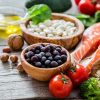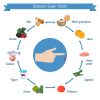“How to control glucose levels” is a constant battle that people with diabetes face. Thankfully, some of the best solutions lie in nature in the form of super foods. These are foods that allow the slow release of glucose during assimilation by the body thereby helping control blood sugar levels. The measure of this factor is the Glycaemic Index (GI).
GI essentially measures how quickly a food will raise blood sugar. Low GI foods have a score of 55 or less while high GI foods have a score of 70 or more. Low GI foods must constitute a considerable part of the diabetic diet.
1. Extra virgin olive oil: Switch from highly refined vegetable oils to extra virgin olive oil and you will get your healthy dose of fats, the monounsaturated way. Minimum processing ensures that its antioxidant and anti-inflammatory components are protected. However, don’t use it in large quantities because it still packs calories (120 calories per tablespoon), but it’s the go-to alternative for stir fries and salads.
2. Non-fat milk and curds: Opt for skimmed milk (GI of 32) and low-fat yogurt (GI of 33) and meet your Vitamin D and calcium requirements to build healthy bones, teeth, and hair.
3. Tomatoes:Tomatoes are a wonder food thanks to the chemical component lycopene, which reduces the risk of cancer, heart disease, and macular degeneration. Their low GI make them a mainstream component of the diabetes diet chart.
4. Citrus fruits: Pulpy citrus fruits like oranges and grapefruit are a great source of fiber. Make sure you eat the fruit rather than extract the juice and have it. Juicing oranges increases the GI from 40 (whole orange) to 50 (orange juice). Grapefruit has amongst the lowest GI (25) of all fruits. Other great fruits are apples, avocados, melons, cantaloupes, pineapple, and papaya.
5. Non-starchy vegetables: Cabbage, lettuce, carrots, cucumber, broccoli, cauliflower, peppers, and mushrooms are must-haves for diabetics. In fact, the American Diabetes Association recommends covering at least half of your plate with non-starchy vegetables at meal times. With plenty of vitamin A, vitamin C, vitamin K, soluble fiber and low carbohydrate content, they are a great way to lower blood glucose levels.
6. Nuts and seeds: Walnuts and flaxseeds are healthy fats with fiber, magnesium, zinc, folic acid, protein and omega-3 fatty acids. This is great for the heart, and often helps reduce the risk of type-2 diabetes. Keep small portions of nuts and seeds handy.They are energising between-meal snacks for diabetics.
7. Beans: Beans are the ultimate protein source.Just half a cup of beans provide about a quarter of your daily fiber requirement! They are also rich in vitamin A thereby protecting your eyes. However, watch out for the relatively high carbohydrate content, especially if you are on a low-carb diet. Opt for black beans, and chick peas, which have low GI scores.
8. Green leafy vegetables: Kale, and spinach are the ideal foods for diabetics with their extremely low GI scores and nutrients. Kale alone provides more than 100% of the recommended daily intake of vitamin A, vitamin C and vitamin K, not to mention the potassium and cancer-fighting compounds. Spinach is amazing to maintain the daily intake of folate, vitamin C, and antioxidant beta-carotene, true to Popeye’s famous claims!
9. Lentils and pulses: Whole grains like barley, jowar, broken wheat etc. have great GI and pack a punch of fiber too. Replace refined wheat with these versions and see your blood sugar levels getting much stabilized.
10. Fish and eggs: Opt for fish like salmon, mackerel, tuna, herring, and sardines that are rich in omega-3 fatty acids. They provide essential nutrients like vitamin D and selenium giving you great hair, skin, and bones. Moreover, fish does not contain carbs and is great for a low-carb diet for diabetes. Watch out for the high mercury levels though.Eggs too are a great protein source, best taken at breakfast in a hard-boiled fashion.
11. Berries: Got the sweet tooth? Now, turn to brightly colored berries like raspberries, strawberries, and pomegranates to appease that sweet craving. Packed with the goodness of antioxidants, fiber and anti-inflammatory properties, they are amongst the best fruits for diabetics.
The best way to incorporate these superfoods in daily meal plans is to discuss and create a diet plan for diabetes along with your nutritionist. This will help you curate a balanced diet including foods from the diabetes food chart and excluding the foods to avoid in diabetes. Choosing the right food for diabetics must become a way of life and not a forced regimen. Now, go ahead and indulge in these diabetes-managers from your food basket and manage your diabetes the healthy, tasty way!
















